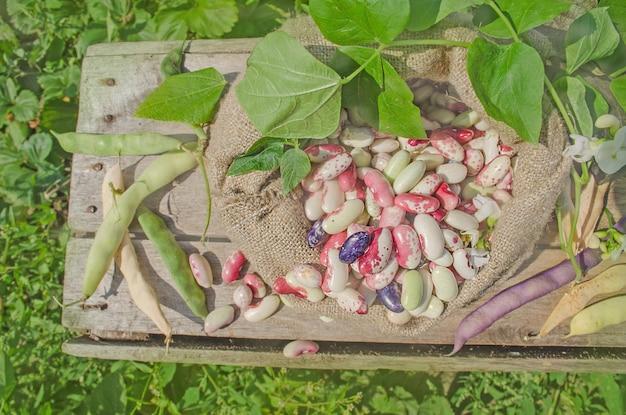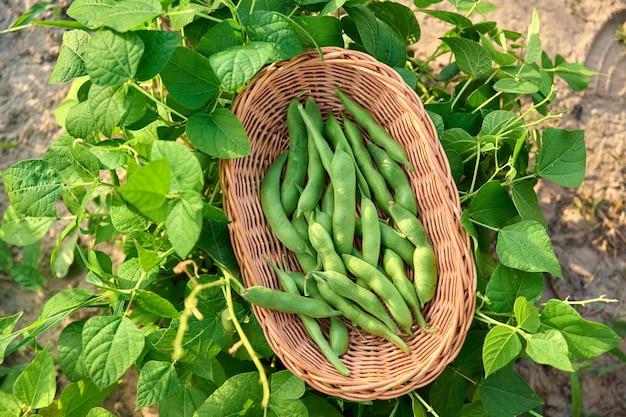Pinto beans, with their distinctive mottled appearance and rich flavor, have become a staple in many cuisines across the globe. But have you ever wondered where these delicious beans come from? In this blog post, we’ll explore the origins of pinto beans and delve into how they are grown.
Although pinto beans are now cultivated in various parts of the world, they have a fascinating history rooted in the United States. Native to the central highlands of Mexico and particularly cherished in Mexican cuisine, pinto beans made their way northward across the border. Today, the majority of pinto beans consumed in the United States are grown in the plains and mountains of Montana, Colorado, Idaho, and Washington.
While traditionally grown in outdoor fields, pinto beans can also be cultivated indoors, allowing you to enjoy these nutritious legumes even if you lack garden space. So, whether you’re curious about the origins of pinto beans, want to grow them yourself, or simply love indulging in their scrumptious flavors, join us as we explore the fascinating world of pinto bean cultivation.
Where Do Pinto Beans Grow
Pinto beans, that popular legume loved by many chili enthusiasts, have a fascinating origin story – one that takes us back to the ancient Mesoamerican civilizations. Fast forward to today, pinto beans continue to be a staple in many households, not just in Mexico, but all across the world. So, where exactly do pinto beans grow? Let’s dive right in and find out!
The Origins: Mesoamerica’s Gift to the World
Pinto beans were first cultivated by the ancient peoples of Mesoamerica, including the Maya and Aztec civilizations. These ingenious farmers discovered the versatility and nutritional value of pinto beans, as they thrived in the region’s fertile soil and warm climate. Pinto beans quickly became a significant part of their diet, offering a source of essential proteins and nutrients.
Present-day Pinto Bean Production
Fast forward to the modern times, the cultivation of pinto beans has spread far beyond Mesoamerica. Today, the United States has become a leading producer of this beloved legume. While pinto beans can be found growing in various states across the country, some regions have become well-known for their exceptional pinto bean production.
The Great State of Idaho
Idaho, famous for its potatoes, also happens to be a fantastic place for growing pinto beans. With its rich volcanic soil, cool nights, and sunny days, Idaho offers the perfect conditions for cultivating high-quality pinto beans. So, next time you’re enjoying a bowl of tasty chili, keep in mind that those delicious pinto beans might just have come from the land of spuds!
Texas, Y’all!
When it comes to pinto beans, Texas doesn’t like to be left out of the spotlight. This Lone Star state knows a thing or two about growing some top-notch legumes. With its warm climate and fertile soil, Texas has made a name for itself as a major player in pinto bean production. So, whether you’re in the mood for a hearty Tex-Mex dish or a classic bowl of cowboy chili, chances are those delightful flavors owe a lot to the Lone Star state.
The Beautiful States of Colorado and New Mexico
Nestled in the rugged landscapes of the American Southwest, Colorado and New Mexico also play a crucial role in the pinto bean game. The arid climate, distinctive terroir, and high-altitude conditions of these states create a unique environment for growing delicious pinto beans. The beans that emerge from these regions are prized for their robust flavor, satisfying texture, and striking colors, making them a sought-after choice for bean enthusiasts.
Pinto beans have journeyed far from their humble beginnings in Mesoamerica. Today, their popularity knows no bounds, thanks to their versatility and delicious taste. Whether they’re grown in the volcanic soils of Idaho, the warm expanses of Texas, or the rugged landscapes of Colorado and New Mexico, pinto beans continue to bring joy to countless kitchens around the world. So, the next time you’re savoring a mouthwatering bowl of chili, take a moment to appreciate the incredible journey these little legumes have made to your plate.
Pinto Beans Growth: Frequently Asked Questions
How do pinto beans grow?
Pinto beans grow as annual plants, meaning they complete their life cycle in one growing season. They are typically planted as seeds in the spring, and with proper care and attention, they mature into lovely bean pods by late summer.
Can you plant pinto beans from the grocery store?
Absolutely! If you have pinto beans from the grocery store, you can definitely plant them. However, keep in mind that beans found in stores are often dried and may have been treated with heat to prevent sprouting. It’s advisable to purchase untreated beans specifically intended for planting if you want to ensure a successful crop.
Where are pinto beans grown in the US?
Pinto beans are primarily grown in the United States in states such as Colorado, Idaho, Nebraska, and Wyoming. These regions provide the ideal climate and soil conditions for their cultivation. However, you can also find pinto bean farms in other states like Montana, North Dakota, and South Dakota.
How do you grow pinto beans indoors?
While pinto beans thrive best in outdoor environments, you can also try growing them indoors. Start by choosing a large container with good drainage. Soak the beans in water overnight, and then plant them in a pot with well-draining soil. Place the pot near a sunny window or provide supplemental lighting. Keep the soil moist but not waterlogged, and watch the beans grow into beautiful indoor plants.
What is the most consumed bean in the United States?
Pinto beans! They are the reigning champions when it comes to bean consumption in the United States. Pinto beans are loved for their rich, nutty flavor and versatility in various dishes, such as chili, burritos, and refried beans. So, it’s no wonder they’re the favorite choice among bean lovers across the nation.
Where are Great Northern Beans grown?
Great Northern Beans are predominantly grown in the northern regions of the United States, such as the states of Michigan, Minnesota, Nebraska, and North Dakota. These areas provide the optimal conditions, including cooler temperatures and well-drained soils, for the successful cultivation of Great Northern Beans.
What is the most eaten bean in the world?
The humble soybean takes the crown for being the most consumed bean worldwide. With its widespread use in tofu, soy milk, oil, and a variety of processed foods, the versatile soybean has secured its place as a staple in many global cuisines. From Asia to the Americas, the soybean knows no boundaries.
Where do beans grow from?
Beans, including pinto beans, grow from seeds. These seeds are usually found inside the bean pods, which develop after the beans flower and are pollinated. The pods gradually fill with beans, maturing into plump and flavorful seeds that are harvested for consumption or saved for future planting.
Is a pinto bean a seed?
Indeed, a pinto bean can be considered a seed. When you plant a pinto bean, it germinates and gives rise to a new plant. Each pinto bean holds within it the potential for growth and the ability to produce more beans. So, whether you call them seeds or beans, they are nature’s tiny powerhouses of sustenance.
Can I grow pinto beans from dried beans?
Yes, you can grow pinto beans from dried beans. Soak the dried beans in water overnight before planting to speed up the germination process. However, keep in mind that some dried beans available for culinary purposes may be treated to prevent sprouting. It’s prudent to obtain untreated beans specifically meant for planting to ensure successful growth.
Are pinto beans hybrid?
No, pinto beans are not typically hybrid varieties. They are mostly open-pollinated or heirloom beans, meaning they are pollinated naturally by wind, insects, or birds, allowing them to maintain their desirable traits over time. However, some farmers and seed companies do breed hybrid varieties to obtain specific characteristics, but they are less common in the case of pinto beans.
What beans are native to Mexico?
Beans hold a special place in Mexican cuisine. Many varieties have found their roots in Mexico, including the beloved pinto bean. Other native Mexican beans include black beans, kidney beans, and navy beans, all of which play essential roles in traditional dishes like frijoles de olla, refried beans, and hearty stews.
Will pinto beans sprout?
Yes, pinto beans have the potential to sprout if they are planted under favorable conditions. However, it’s important to note that some pinto beans available for culinary use may have been treated to prevent sprouting. So, if you want to grow pinto beans specifically, it’s best to acquire seeds intended for planting.
Do pinto beans come from green beans?
No, pinto beans do not come from green beans. Green beans, also known as snap beans or string beans, are harvested before the bean pods fully mature. On the other hand, pinto beans are allowed to mature and dry on the vine before they are harvested for consumption or used for planting.
Are pinto beans grown in the US?
Absolutely! Pinto beans are not only grown in the US but also have a significant presence in the country’s agricultural landscape. Several states, such as Colorado, Idaho, Nebraska, and Wyoming, embrace pinto bean farming due to suitable soil and weather conditions. So, when you enjoy those delicious pinto bean dishes, you can savor the taste of homegrown goodness.
Why do pinto beans have rocks in them?
Well, it’s not rocks you’re finding in your pinto beans, but rather something called “foreign material.” During the harvesting and processing of pinto beans, small stones or debris may accidentally be mixed in. That’s why it’s important to sort and rinse the beans before cooking them – nobody wants unwelcome surprises in their culinary creations!
What race eats the most beans?
Beans are beloved across various cultures and cuisines, but one could say that Latinx communities have a special affinity for these legumes. With their rich traditions of cooking delicious bean recipes, Latinx individuals and families tend to consume beans more extensively than other ethnic groups. However, it’s safe to say that beans have universal appeal and are enjoyed worldwide.
Are black beans or pinto beans better for you?
Black beans and pinto beans both offer excellent nutritional benefits, so it’s a win-win situation. While black beans tend to have slightly higher levels of antioxidants and fiber, pinto beans are a fantastic source of protein and essential minerals. Ultimately, choosing between them comes down to personal preference and the specific recipe or dish you’re preparing.
Are pinto beans bush or pole?
Pinto beans are typically bush beans rather than pole beans. Bush beans are compact plants that don’t require additional support structures to grow. They tend to be easier to manage and harvest compared to pole beans, which need trellises or stakes to climb on. So, when it comes to pinto beans, you can enjoy the simplicity of compact, bushy plants.
What state eats the most beans?
When it comes to bean consumption, certain states in the US take the lead. The honor of consuming the most beans goes to North Dakota. Whether it’s their love for comforting bean soups during cold winters or their appreciation for bean-filled hotdishes, North Dakotans sure know how to celebrate the culinary versatility of beans.
What country loves beans?
While beans are cherished in various countries worldwide, no nation adores them more than Brazil. In Brazil, beans are a dietary staple and are incorporated into traditional dishes like feijoada, a hearty and flavor-packed black bean stew. It’s safe to say that beans have an inseparable place in the heart and cuisine of this beautiful South American country.

